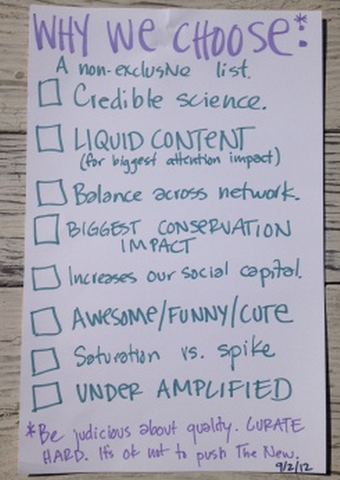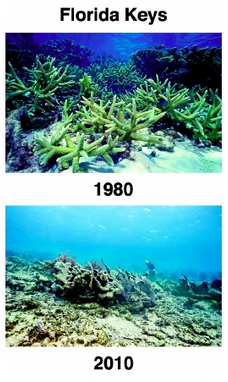Why We Choose What We Choose (Upwell Curation Criteria)
Upwell is not a newswire for the ocean. It does not exist solely to pump out out retweets and links; if it did, it would be adding to the noise without necessarily increasing volume in a valuable way. So we subject the mass of possible topics to a triage test.

Version 2.0 of Upwell’s curation criteria, September 2, 2012
The first items to be discarded are those that don’t pass the scientific smell test; if the science isn’t credible, it’s out. Other considerations include:
Socially Shareable.
In order to be as effective as possible, it’s important to select topics that lendthemselves most easily to wide and willing dissemination, and spark conversation: what wedescribe as ‘liquid content.’ This can either be content that is already liquid—for example,content that is visual, awesome, scary, funny or cute—or that we can make liquid. The publication of a National Research Council report evaluating the federal response plan to ocean acidification is undoubtedly important—but seriously, what are you more likely to share with friends? That, or this:

Before-and-after pics. Good for US Weekly, good for Upwell.
Exactly.
Conservation Impact.
We’re a movement with a message. Not everything we share or amplify is Debbie Downer material. We also celebrate good news and successes and also highlight the awesomeness of ocean life. Even so, as part of our morning triage, we prioritize campaigns that have not just a generic conservation message, but the potential for specific impact: for example, petitions, seafood purchasing recommendations, etc. We find that content that is paired with action is more shareable.
Building Social Capital.
We calibrate our focus across issues, people and organizations in orderto cultivate trust, animate our network and maintain access to the most compelling oceancontent. We share content that comes from every corner of Team Ocean, with an effort toward spreading the love in a balanced way. If an important influencer asks us to share something, we do it. Generosity builds and maintains relationships, thereby increasing our social capital.
New Influencers.
We are always looking to grow our network and expand to new audiences.We prioritize content and campaigns that allow us to go beyond the choir and reach new influencers to enlarge the conversation and build the network.
Topical.
Sometimes the hook is an article in the New York Times that’s generating discussion onTwitter. Sometimes there is no hook, and we have to find it, or make it. Tying ocean content with events like the Olympics, Rio+20 or Lance Armstrong’s steroid use helps up the shareable quotient.
Spikeability.
Has a news story or piece of content already reached its saturation point? If something has already received a lot of coverage and attention, we judge whether it's worth our effort to create another spike in attention (like an aftershock) or if it's already been shared by as many people as it will be (saturated). Often, the best way to judge whether something is spikeable is to ask whether the content will be shared two or three degrees out of our network. Will it generate interest and conversation beyond Team Ocean?
Under Amplified.
We look for awesome news and content that we think has been egregiously under-amplified. Sometimes a hot piece of news just wasn't packaged in the right way. We mine our network and find the awesome stuff that few have seen, and we repackage it to go farther.
Add a comment